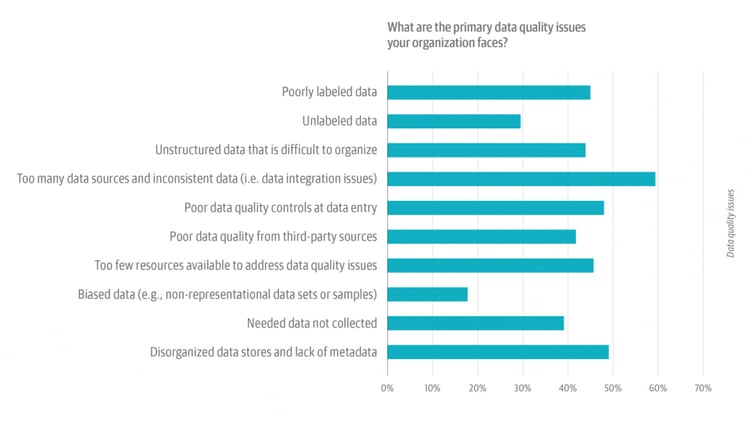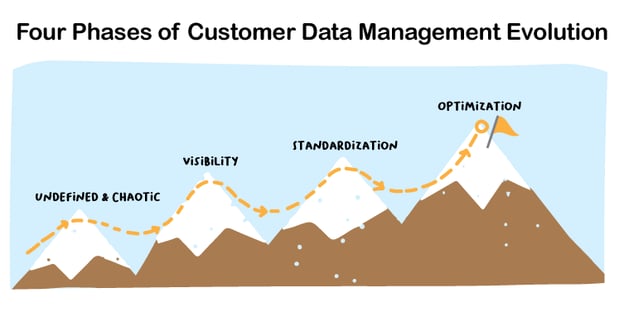In a world where data drives our marketing, sales, and customer success initiatives, bad data is an increasing problem for companies of all sizes.
At this very moment, your company is missing out on revenue due to bad data in your HubSpot databases. That’s right. Bad data is a fact of life for any company that collects and uses even moderate amounts of customer data.
A data entry error might keep a marketing email from being delivered to a prospect who would have ultimately responded well and become a long-term customer. Maybe a data capture error kept vital information about prospects from sales reps, causing them to underperform during sales calls. Or, maybe you’ve wasted valuable time sending marketing materials to leads with outdated records, spending a significant portion of your budget with nothing to show for it. There is no limit to the ways that bad business data can have a negative impact.
Often, a small bad data-related incident, like the ones we just mentioned, will spark a deeper investigation into how bad data is affecting a company in other ways. Almost always, companies that ask those questions determine that the impact is more substantial than they had initially suspected—and that it has actually resulted in many missed opportunities.
Here are a few statistics that show just how serious the problem is:
- A study from The Data Warehousing Institute found that poor data costs U.S. companies more than $600 billion per year.
- In another study, IBM found that data problems could be costing U.S. companies as much as $3.1 trillion per year in 2016. The figure received a lot of attention when the study first came out.
- 44% of companies have no data governance plan in place.
The image below shows the range of data quality issues organizations face.

Source: O’Reilly
In a rush to provide ever-more personalized marketing messages, many companies have focused simply on collecting more data—without giving enough thought to ensuring the integrity of the data in their HubSpot accounts. Today, 33% of companies have more than 100,000 records in their database. But most companies believe up to 25% of their data may be inaccurate.
Bad HubSpot data doesn’t always just lead to a single missed opportunity. It can have a cascading negative effect throughout a company. Bad email data entry practices, for instance, lead to more bounced emails and impact the whole company’s reputation among email providers.
Let’s take a look at exactly how low-quality data harms your marketing efforts.
How Does Dirty Data End Up in Your HubSpot Marketing Database?
One of the biggest surprises companies turn up when they start digging into their HubSpot data is the sheer volume of bad and inaccurate data in the average database. When you collect data, you do so with the best intentions. It’s not that hard for a prospect—or your team—to enter their information correctly, right? Wrong. Any data collection program that requires manual human input is going to experience data entry errors.
But dirty data in your HubSpot marketing database can result from many sources:
- manual entry errors
- data that’s been entered in the wrong field
- Improperly formatted data
- duplicate data
- errors during import or export
- versioning mistakes
- misspellings, typos and other errors
- integration issues that break the sync
A contact or company record with any of these issues is problematic for your marketing and sales teams.
No matter where your bad data comes from, it can significantly water down the success of your marketing campaigns. A contact record with issues is inherently less valuable to your organization than one that is clean. This is why HubSpot data quality is so critical. Let’s take a look at the three biggest reasons all companies should consider instituting data integrity and quality assurance programs.
3 Ways Bad HubSpot Data Quality Hurts Your Marketing
There are many ways that bad data can harm your marketing and sales campaigns. Sometimes this impact will be specific to your own campaigns. But there are some common ways low-quality data impacts campaigns—resulting in those billion-dollar losses we detailed above.
1. Low-Quality Data Makes Lead Scoring Difficult
Lead scoring is at the center of some of the most successful B2B marketing campaigns. Knowing where to focus your attention and being able to identify what stage of the buying process individual leads are in, is critical for optimization. However, 79% of B2B marketers have not established lead scoring within their marketing operations.
Lead scoring relies heavily on your ability to collect accurate data from prospects. You need to collect enough data to gain a complete picture of each prospect to score them accurately. You can’t use what you don’t collect. But it’s critical to make sure that you don’t sacrifice data quality in your HubSpot databases in your effort to scale the data you collect.
Duplicate HubSpot records can make lead scoring difficult. Sometimes, the same lead will get scored twice and receive two completely different scores. Then, when a salesperson is assigned that lead, their approach will be dictated by which record they were assigned. Beyond that, the wrong record might receive updates. This can make it difficult to track and identify relevant companies in your HubSpot database—resulting in lost sales.
Errors in your data mean errors in the scores that you assign to leads and accounts. What if a company’s estimated annual revenue was incorrectly entered? If the amount listed in the Hubspot database was substantially lower than the company’s revenue, all associated leads would have incorrect scores, due to the lower revenue opportunity.
It’s impossible to quantify the cost of missing out on these leads without a full data quality audit. Even then, you can’t maintain data quality without consistent effort. Improving data quality assurance for your HubSpot data means a large time commitment from your teams, investing in tools, and working to improve how you collect that data.
Poor data quality that results in lead scoring mistakes also leads to suboptimal time management for your sales teams and marketing teams. They’ll focus on the wrong leads. They’ll spend time preparing based on inaccurate data. They’ll have less confidence in the lead data that they do receive and will spend more time on their own research.
2. Deep Personalization Requires Confidence in Your Data
Personalization has never been more important than it is today, and its usage will only grow as time goes on. Companies are working toward deeper, more data-rich personalization based on the actions that their customers take all the time. HubSpot builds deep personalization into all of its features, allowing you to speak directly and specifically to your customers about their problems and needs.
Such personalization has become so prevalent that modern customers expect it. In fact, 78% of customers will only engage with offers if they have been personalized and reflect their previous engagements with a company.
There is no question that personalization is effective. But companies need to have a wealth of data to achieve the true, deep personalization they seek and that HubSpot is able to provide.
With that data, there needs to be a certain level of confidence. The only thing worse than not using personalization in HubSpot marketing campaigns is doing it and getting it wrong. Without confidence in your data, you can’t leverage opportunities to inject data into your campaigns.
If you don’t have confidence in your data, you’ll have a hard time designing fully-formed personalization campaigns that fulfill their potential.
Ultimately, your marketing team's ability to harness data is limited by your HubSpot data quality. Without confidence in your data, much of it will sit there unused.
3. Inaccurate Marketing Data Negatively Impacts Brand Perception
Inaccurate marketing data doesn’t just affect your bottom line. It also negatively impacts the perception of your brand. Imagine being shown marketing that has been “personalized” but uses inaccurate data. Maybe an email calls you by the wrong name. Or worse, it calls you “[firstname].” The communication could address you by the wrong job title, or associate you with the wrong company. Wouldn’t that affect your opinion of the brand?
Those early impressions of your brand stick. Once customers develop a negative opinion of your brand, 70% of customers will avoid buying your products.
When prospects receive ads that incorrectly use personalization data or fail to deliver their message in a way that resonates, it can be a frustrating experience. Additionally, dirty HubSpot CRM data can cause sales reps to reach out to prospects using inaccurate data to drive their engagements, derailing conversations, and killing conversion rates. The impact of bad data flows throughout an organization. It’s never isolated to a single campaign or issue.
|
Related articles The Business Impact of Not Maintaining CRM Data Declutter Your CRM By Purging Low-Quality Data Automatically How to Merge Duplicates in HubSpot and Salesforce and Keep them Syncing |
Steps Companies Can Take to Protect Themselves
Bad CRM data can seriously impede your marketing and sales campaigns. Luckily, companies don’t have to be stuck with dirty data forever. You can take steps to rectify your current data quality problems and put yourself in a position to mitigate them moving forward:
- Launch a comprehensive HubSpot data audit. You can make all of the changes to your processes that you want to avoid future data quality issues, but you still have to start by identifying and fixing current issues in your HubSpot CRM data. Using a tool like Insycle’s Data Health Assessment, which surfaces 30+ common types of issues in your customer data, can give you a clean slate moving forward.
- Make proper data collection a priority. Take steps to ensure that when you collect data, you are collecting it the right way. This is especially true for any manually entered data—whether it is from customers or your own internal teams. Make sure that different form fields have the correct input formatting requirements, or are automatically checked for accuracy before inclusion in your HubSpot CRM.
- Schedule regular and ongoing data maintenance. Where there is data, there is a variance in the quality of that data. You will always have to maintain your data, so make sure that you have solutions and processes in place that facilitate ongoing data quality improvement. Insycle is a HubSpot customer data management solution that offers in-depth HubSpot data automation features. These features allow you to clean your database in a variety of ways and schedule those same tasks to run automatically regularly. The system provides true data cleansing automation, ensuring that your database always contains accurate data that you can rely on.
- Use software solutions to reduce manual editing and input. Human error is one of the biggest drivers of poor data quality. HubSpot offers numerous ways to streamline and automate data collection and limit human error in manually entered data. Reduce the amount of manual input from your customers and teams wherever you can. When it is unavoidable, use software solutions to ensure conformity, catch duplicates, and identify other issues.
By following these best practices, you put yourself in position to protect your data, improve data quality going forward, and maximize confidence in your CRM data.

Four Phases of Customer Data Management Evolution
Clean, Quality Data Drives Better Results
High-quality HubSpot CRM data drives alignment between your marketing, sales, and customer success teams. It helps to achieve a single customer view, where all teams are working with the same, accurate records to drive their tactics and initiatives.
Clean data allows you to improve lead scoring so that your team can focus on engagements with higher value accounts. Then you can improve your personalization efforts throughout your campaigns.
However, inaccurate marketing data can harm how customers perceive your brand.
Want to improve customer experiences, be more efficient, and grow more quickly? Improving your data quality might be a good place to start. Learn more about how Insycle facilitates effective HubSpot data management across your organization.





